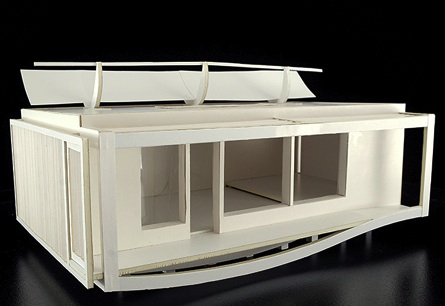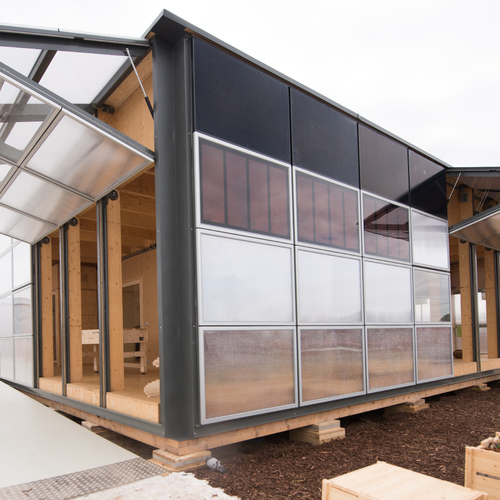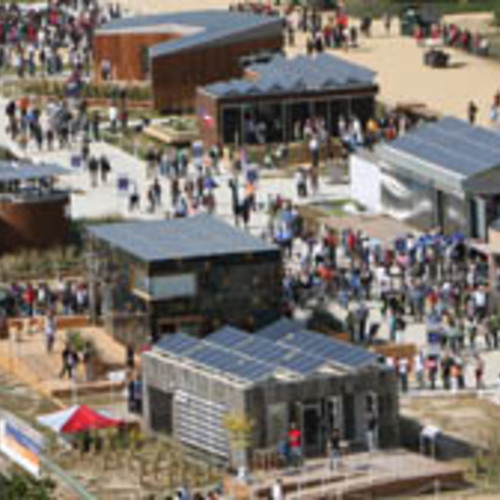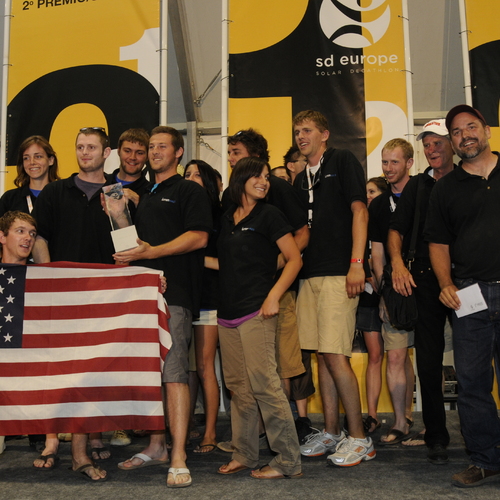
Image Credit: Solar Decathlon Europe
Image Credit: Solar Decathlon Europe Fachhochschule fur Technik und Wirtschaft Berlin's Living Equia House, whose roof manages heat absorption via a layer of phase-change materials that includes wax globules. Instituto de Arquitectura Avanzada de Cataluña's Fablabhouse has, so far, attracted the most attention of all the Decathlon Europe models posted on the Internet. (Model created by Alonso Huerta.) A more fully realized rendering of Fablabhouse, whose paraboloid shape is intended to optimize its exposure to the sun. Though the exposed underside won't benefit from the ground's insulation, the designers said elevating the house will allow them to experiment with ventilation strategies, evaporative cooling, wind dynamics, and creating a structural core with thermal inertia. University of Florida's Re-Focus House, a modular dwelling inspired by the "cracker houses" common to North Florida in the nineteenth-century. University of Nottingham's Nottingham H.O.U.S.E., another project that will rely on prefab components, and one of the few entries featuring two-story construction.
The Solar Decathlon’s biennial presentations on the National Mall in Washington, D.C., have become high-profile showcases for the academic institutions that participate in them. Each of the 20 or contestants – teams that include various combinations of students and faculty – apply all the brainpower they can muster to design, build, transport, and eventually display sustainably built, comfortable, PV-equipped, net-zero-energy dwellings no larger than 800 sq. ft. apiece.
As we’ve noted in previous posts, competing in a Solar Decathlon is a prestige gig, and the showcase has become a potentially rich resource for consumers and for engineers, builders, and others interested in developing markets and technologies for green construction. None of this has been lost on the many Decathlon teams from Europe, where the European Parliament and many of its member countries have promoted ambitious programs to reduce greenhouse gas emissions, including initiatives aimed at improving the energy efficiency of residential and commercial buildings.
Hands across the water
In October 2007, officials representing Spain’s Ministry of Housing and the Energy Efficiency and Renewable Energy department of the U.S. Department of Energy signed an agreement that would establish the Solar Decathlon Europe, whose first two competitions are scheduled to be held in June 2010 and in 2012 (since 2005, the U.S. Solar Decathlon has been scheduled for odd-numbered years, with the next one set for 2011).
The lineup for Solar Decathlon 2010 naturally features many European institutions, although the contest is open to universities worldwide. Nineteen competitors are scheduled to present: Arts et Métiers Paris Tech (whose project is called Napevomo House); Fachhochschule fur Technik und Wirtschaft Berlin (Living Equia); Bergische Universität Wuppertal (Team Wuppertal); Universidad CEU Cardenal Herrera (SML House); Ecole National Supérieure d’architecture de Grenoble (Armadillo Box-6); Stuttgart University of Applied Sciences (Stuttgart Team); Helsinki University of Technology (Luukku House); Instituto de Arquitectura Avanzada de Cataluña (Fablabhouse); Instituto Tecnológico y de Estudios Superiores de Monterrey (K´IIN); University of Applied Sciences Rosenheim (Ikaros); Tianjin University (Sunflower); Consórcio Brasil (Casa Solar Flex); Universidad de Sevilla (Solarkit); Universidad de Valladolid (La Envolvente del Urcomante); University of Nottingham (Nottingham H.O.U.S.E.); University of Florida (Re-Focus); Universidad Politécnica de Cataluña (Low3); Universidad Politécnica de Valencia (On&On); and Virginia Polytechnic Institute & State University (Eclipse).
Weekly Newsletter
Get building science and energy efficiency advice, plus special offers, in your inbox.














0 Comments
Log in or create an account to post a comment.
Sign up Log in